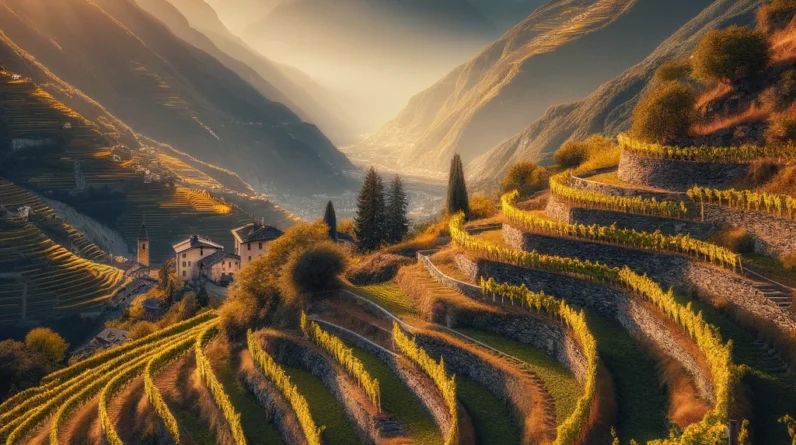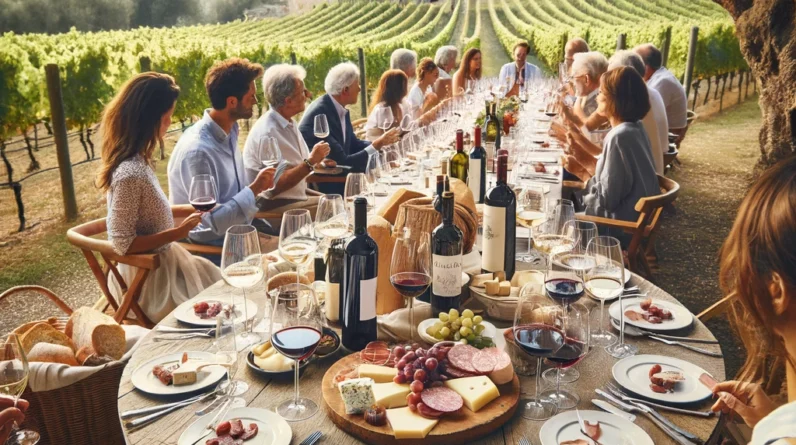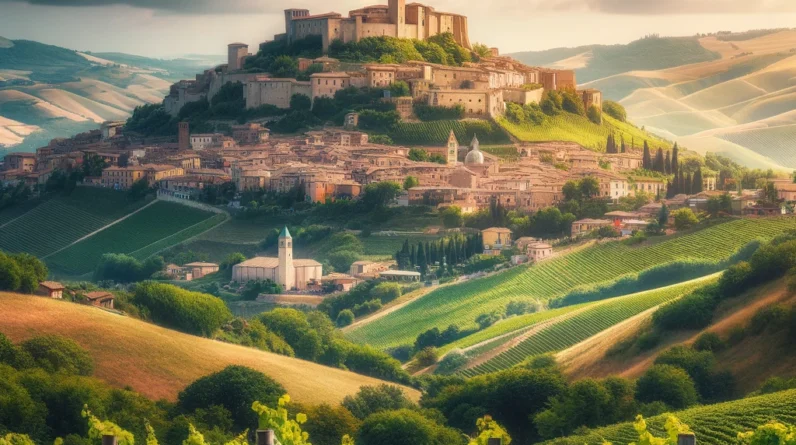
Exploring the Hidden Gem of Italy’s Wine Country: Friuli Venezia Giulia
Welcome to a journey through the lush vineyards and exquisite wines of Friuli Venezia Giulia, Italy’s northeastern viticultural paradise.Wines and Vineyards of Friuli Venezia Giulia
Nestled between the Adriatic Sea and the Alps, this region is a hidden gem in the world of wine, offering a rich tapestry of flavors, traditions, and pioneering winemaking practices.
In this article, we will embark on a captivating exploration, uncovering the secrets of Friuli Venezia Giulia’s famed wines and vineyards.
From the aromatic whites to the robust reds, the family-run estates to the modern wineries, and the traditional gastronomy to innovative winemaking techniques, get ready to discover the soul of Italian winemaking in one of its most underrated regions.
Join us as we delve into the heart of Friuli Venezia Giulia, where each bottle tells a story of heritage, craftsmanship, and the joy of Italian living.
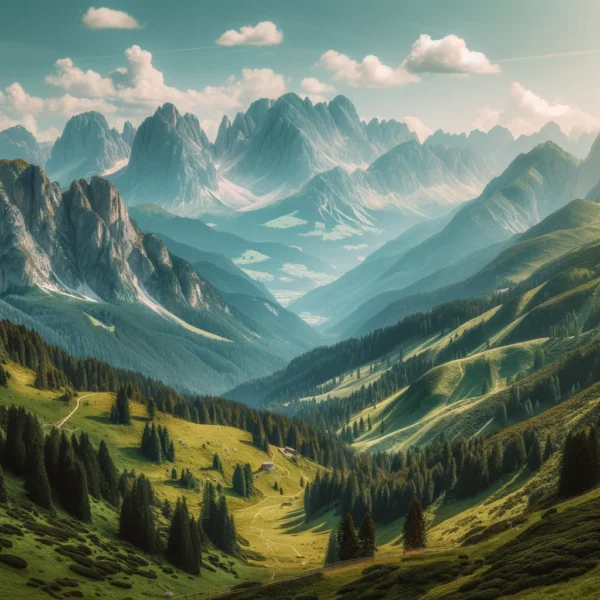
Overview of Friuli Venezia Giulia
Nestled in the Northeastern Corner of Italy
Friuli Venezia Giulia, a serene and picturesque wine region, lies in Italy’s northeastern corner, bordering Slovenia and the Adriatic Sea.
This region, though less famed than Tuscany or Piedmont, is a hidden gem that has quietly carved out a prestigious niche in the world of viticulture.
A Mosaic of Terroir and Microclimates
What makes Friuli Venezia Giulia truly unique is its remarkable mosaic of terroir and microclimates.
The region benefits from a distinctive mix of alpine and Mediterranean climates.
The Julian Alps shield the vineyards from cold northern winds, while the Adriatic Sea moderates the climate, offering a favorable environment for a diverse range of grape varieties.
The Soil Speaks to the Vines
The soils in this region are as varied as the climate.
From the rocky, mineral-rich soils in the hilly areas, which impart a unique minerality to the wines, to the fertile plains that produce more fruit-forward styles, the land of Friuli Venezia Giulia is a viticulturist’s paradise.
This diversity in soil composition plays a pivotal role in the character and complexity of its wines.
A Spectrum of Grape Varieties
Friuli Venezia Giulia is a haven for white wine enthusiasts, famed for its indigenous varieties like Friulano, Ribolla Gialla, and Malvasia Istriana.
These grapes yield wines that are renowned for their crisp acidity, complex aromatics, and elegant minerality.
The region also embraces international varieties such as Chardonnay and Sauvignon Blanc, which have found a unique expression in this terroir.
But let’s not forget the reds!
Although the region is predominantly known for its whites, grapes like Refosco dal Peduncolo Rosso, Merlot, and Schioppettino thrive here, producing rich, flavorful reds with a distinct identity.
| Grape Variety | Flavor Profile | Predominant Use in Friuli Venezia Giulia | Type |
|---|---|---|---|
| Friulano (formerly Tocai)
| Almond, pear, floral notes | Standalone varietal wines | White |
| Ribolla Gialla
| Citrus, floral, apple, mineral notes | Varietal wines, sparkling wines | White |
| Pinot Grigio
| Lemon, pear, apple, white peach, floral | Single varietal wines, blends | White |
| Chardonnay
| Green apple, lemon, pineapple, hint of oak | Varietal wines, often oak-aged | White |
| Sauvignon Blanc
| Green apple, passion fruit, bell pepper, herbaceous | Single varietal wines | White |
| Malvasia Istriana
| Peach, apricot, citrus, floral | Single varietal wines | White |
| Pinot Bianco
| Green apple, citrus, floral, mineral | Single varietal wines, sparkling wines | White |
| Refosco dal Peduncolo Rosso
| Dark berries, plum, herbaceous, earthy | Single varietal wines, sometimes in blends | Red |
| Merlot
| Plum, blackberry, cedar, tobacco | Single varietal wines, blends | Red |
| Cabernet Franc
| Raspberry, bell pepper, cassis, earthy | Single varietal wines, blends | Red |
| Schioppettino
| Black pepper, violet, blackberry, spicy | Single varietal wines, occasionally in blends | Red |
Climate: A Balancing Act of Nature
The climate of Friuli Venezia Giulia is a harmonious blend of maritime and continental elements.
The warm sea breezes and cool mountain air converge to create an ideal setting for slow, balanced grape ripening.
This results in wines that not only boast intensity and complexity but also retain a refreshing acidity – a signature of the region’s wines.
Friuli Venezia Giulia is not just a wine region; it’s a testament to the harmony between nature and viticulture.
Its unique terroir, diverse soils, varied climate, and a mix of both indigenous and international grape varieties come together to create wines that are as memorable as they are diverse.
It’s a region where each sip tells a story of the land, climate, and the passion of its winemakers.

Vineyard Information
Friuli Venezia Giulia’s vineyards are as diverse as they are numerous.
They range from small, family-run estates to larger, more modern operations.
Each vineyard has its own story, often tied to family heritage and traditional winemaking methods.
The region’s terroir is a complex blend of soils, from limestone to clay, contributing to the unique flavor profiles of its wines.
| Vineyard Name | Designation | Grape Varieties |
|---|---|---|
| Jermann
| Venezia Giulia IGT | Chardonnay, Sauvignon Blanc, Ribolla Gialla |
| Livio Felluga
| Collio DOC | Friulano, Pinot Grigio, Sauvignon Blanc |
| Schiopetto
| Collio DOC | Malvasia, Ribolla Gialla, Pinot Bianco |
| Marco Felluga
| Collio DOC | Merlot, Cabernet Franc, Refosco dal Peduncolo Rosso |
| Ronchi di Cialla
| Cialla Valley DOC | Ribolla Gialla, Picolit, Refosco dal Peduncolo Rosso |
| Vie di Romans
| Isonzo DOC | Chardonnay, Sauvignon Blanc, Pinot Grigio |
| Russiz Superiore
| Collio DOC | Cabernet Franc, Sauvignon Blanc, Friulano |
| Lis Neris
| Isonzo DOC | Pinot Grigio, Chardonnay, Sauvignon Blanc |
| Venica & Venica
| Collio DOC | Friulano, Sauvignon Blanc, Malvasia Istriana |
| Miani
| Colli Orientali del Friuli DOC | Merlot, Chardonnay, Sauvignon Blanc |
Note: The designations (DOC, IGT) refer to the Italian wine classification system.
DOC (Denominazione di Origine Controllata) signifies high-quality wines from specific regions, while IGT (Indicazione Geografica Tipica) indicates wine from a broader geographic area.
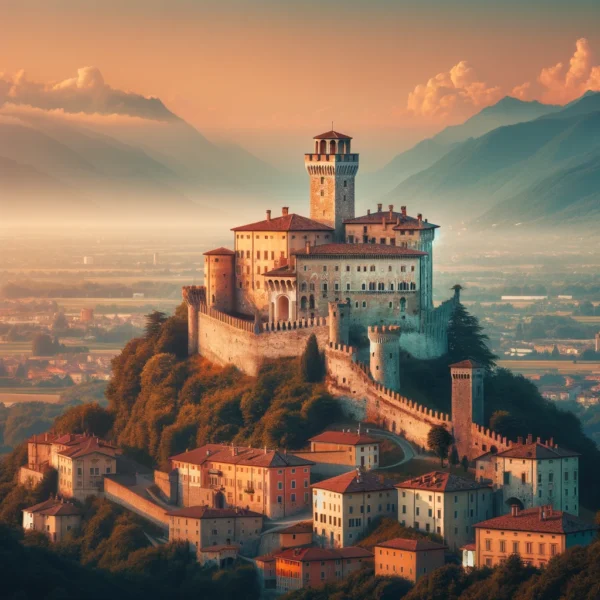
Winemaking Techniques in Friuli Venezia Giulia
Friuli Venezia Giulia is not just a prolific wine-producing region; it’s a hub of winemaking innovation and tradition.
Here’s a look at some of the key winemaking techniques used in this remarkable region.
White Winemaking with Extended Skin Contact
One of the most distinctive techniques in the region, especially for white wines, is extended skin contact.
Traditionally, white wines are fermented without skins, but in Friuli Venezia Giulia, some winemakers ferment white grapes with their skins for days, weeks, or even months.
This process, often associated with ‘orange wines,‘ imparts a unique character to the wines, including added complexity, body, and tannins.
Use of Indigenous Yeasts
Many producers in Friuli Venezia Giulia favor the use of indigenous yeasts for fermentation.
These naturally occurring yeasts, which are present on the grape skins, contribute to the development of unique, terroir-driven flavors in the wine.
Barrel and Oak Aging
The use of oak barrels for aging is a common practice, particularly for certain white wines like Chardonnay and some reds.
This process adds complexity, enhances the wine’s texture, and imparts subtle flavors like vanilla and spice.
Stainless Steel Fermentation
To preserve the fresh, crisp characteristics of white wines, many winemakers in Friuli Venezia Giulia use stainless steel tanks for fermentation and aging.
This method keeps the wines vibrant and fruit-forward.
Amphora Aging
Some winemakers have embraced the ancient technique of aging wine in terracotta amphoras.
This method, which predates oak barrel aging, is believed to impart a unique minerality and texture to the wine, while also allowing for a very gentle oxygen exchange.
Blending and Single-Varietal Focus
The region is known for both its blended wines and its single-varietal wines.
Winemakers skillfully blend different grape varieties to create complex, balanced wines, but they also produce exceptional wines that focus on showcasing the unique characteristics of a single grape variety.
Low Intervention and Organic Practices
There’s a growing trend towards low-intervention, organic, and biodynamic winemaking practices in Friuli Venezia Giulia.
These methods emphasize minimal chemical use, respect for the land, and letting the natural processes dictate the course of winemaking.
Cold Maceration
Before fermentation, some winemakers employ cold maceration for both reds and whites.
This process involves chilling the grapes or must (the freshly pressed grape juice that contains the skins, seeds, and stems) to extract flavor, color, and tannins before the start of fermentation.
Each of these techniques contributes to the distinctiveness of Friuli Venezia Giulia’s wines.
They are a testament to the region’s ability to balance innovation with tradition, continually producing wines that are as diverse as they are captivating.

The Uniqueness of Friuli Venezia Giulia
Friuli Venezia Giulia wines hold a special place in the world of viticulture for several compelling reasons.
Unique Terroir and Microclimates
This northeastern Italian region boasts a rare combination of alpine and Mediterranean climates.
The Julian Alps protect the vineyards from harsh northern winds, while the warm breezes from the Adriatic Sea create a uniquely balanced microclimate.
This mix results in a perfect environment for growing a wide variety of grapes, each expressing distinct characteristics.
Exceptional White Wines
Friuli Venezia Giulia is particularly renowned for its white wines.
The region produces some of Italy’s most celebrated and distinctive whites, characterized by crisp acidity, complex aromatics, and elegant minerality.
Varieties like Friulano, Ribolla Gialla, and Malvasia Istriana are not just regional specialties but are also considered benchmarks for Italian white wines.
Diverse Grape Portfolio
Alongside its famous white varieties, the region also cultivates several red varieties like Refosco dal Peduncolo Rosso, Merlot, and Schioppettino, offering a diverse range of flavors.
This variety ensures that the region caters to a broad spectrum of wine preferences.
Innovative Winemaking Practices
Friuli Venezia Giulia is known for its innovative approach to winemaking.
Many producers in the region experiment with winemaking techniques, including skin contact for white wines (creating the “orange wines”) and using amphoras for fermentation and aging, blending traditional methods with modern technology.
Quality over Quantity
The focus in Friuli Venezia Giulia is firmly on quality.
Winemakers in the region often prefer lower yields to ensure higher quality grapes, leading to wines that are rich in flavor and complexity.
Soil Diversity
The region’s varied soils, ranging from limestone and sandstone in the hillier areas to richer, more fertile soils in the plains, contribute to the unique flavor profiles of the wines.
This geological diversity allows for a wide range of wine styles within a relatively small area.
Culinary Harmony
The wines of Friuli Venezia Giulia are not only appreciated on their own but are also celebrated for their compatibility with the region’s cuisine.
The local food, known for its simple yet rich flavors, pairs wonderfully with the region’s wines, creating a harmonious blend of taste and tradition.
Friuli Venezia Giulia’s wines are special because of their unique blend of diverse terroir, a wide range of grape varieties, innovative winemaking, focus on quality, soil diversity, and their deep connection with local culinary traditions.
These factors come together to create wines that are not just beverages but reflections of the region’s rich cultural and natural heritage.
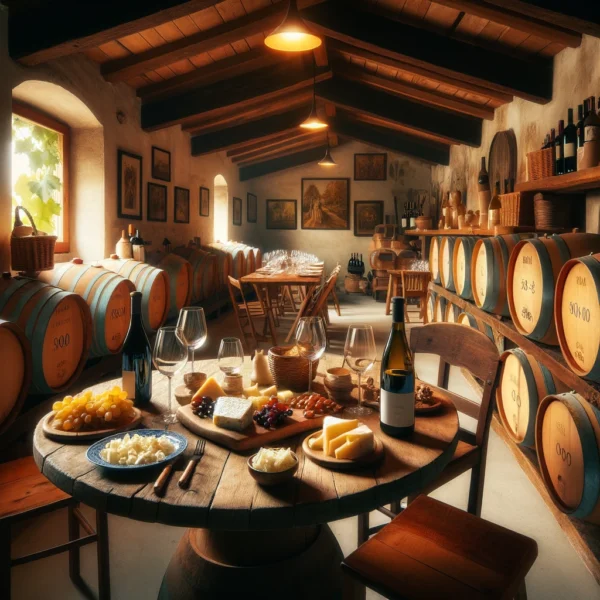
Wine Tasting and Tours
Wine tourism is booming in Friuli Venezia Giulia.
Many vineyards offer tastings and tours, allowing visitors to experience the winemaking process up close.
These tours are not just about tasting; they’re educational, showcasing the intricate process of turning grapes into the exquisite wines the region is known for.
Friuli Venezia Giulia, nestled in the northeastern part of Italy, is not only a paradise for wine lovers but also a region rich in history, natural beauty, and cultural diversity.
Here are some special places to visit:
Trieste
The region’s capital, Trieste, is a vibrant city with a unique history, having been influenced by Italian, Austro-Hungarian, and Slovenian cultures.
Don’t miss the Piazza Unità d’Italia, one of Europe’s largest sea-facing squares, and the Miramare Castle, with its stunning views of the Adriatic Sea.
Aquileia
This UNESCO World Heritage site was once a major Roman city.
Today, it’s home to some of Italy’s most significant archaeological treasures, including ancient mosaics and ruins.
Cividale del Friuli
Another UNESCO World Heritage site, known for its Lombard history.
The Lombard Temple and the Devil’s Bridge over the Natisone River are must-see attractions.
The Dolomites
Part of the Southern Limestone Alps, the Dolomites in this region offer breathtaking scenery, perfect for hiking in the summer and skiing in the winter.
Udine
A charming town with Venetian influences, Udine is home to beautiful squares like Piazza della Libertà and landmarks such as the Udine Castle.
Grado and the Adriatic Coast
Grado, known as the “Sun Island,” offers beautiful beaches and a quaint old town.
The nearby Marano Lagoon is a haven for birdwatching and enjoying unspoiled nature.
Gorizia
This town, right on the border with Slovenia, is a symbol of the melding of cultures in the region.
The Gorizia Castle offers panoramic views and a glimpse into the area’s history.
The Wine Roads
Exploring the Strada del Vino e dei Sapori (Wine and Flavors Road) of Friuli Venezia Giulia is a must.
It takes you through picturesque vineyards, traditional wineries, and offers opportunities to taste the region’s culinary delights.
The Alpe-Adria Trail
For outdoor enthusiasts, this trail is perfect for experiencing the natural beauty of the region, from the mountains to the sea.
Carnia and the Alpine Villages
The mountainous area of Carnia showcases traditional alpine architecture and offers a peaceful retreat with stunning alpine scenery.
Each of these places encapsulates a different aspect of Friuli Venezia Giulia’s rich tapestry, offering visitors a diverse and enriching experience beyond the vineyards.
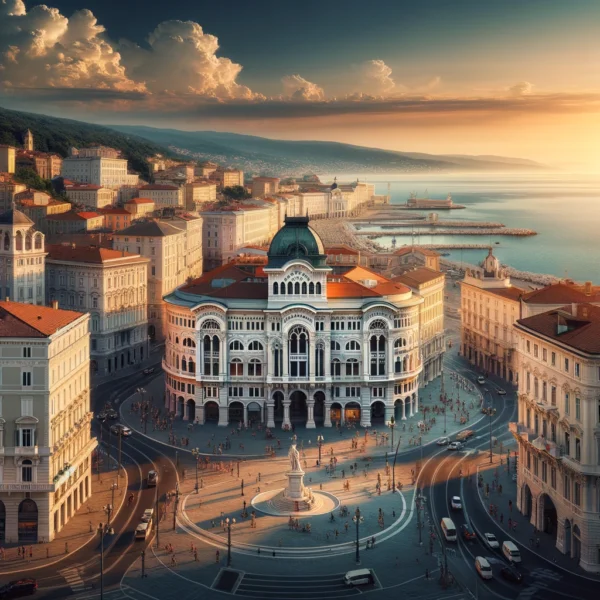
Practical Tips on Visiting Friuli Venezia Giulia
Visiting Friuli Venezia Giulia can be a delightful experience, and here are some practical tips to make the most of your trip:
Best Time to Visit
The best time to visit is late spring (May-June) or early fall (September-October).
These periods offer pleasant weather and fewer crowds. Additionally, fall is harvest season, a fantastic time for wine enthusiasts.
Language Prep
While many in the tourism industry speak English, learning a few basic Italian phrases can enhance your experience and interaction with locals.
Getting Around
Renting a car is highly recommended.
The region is well-connected by roads, and having a car provides the freedom to explore the vineyards and smaller towns at your own pace.
Wine Tastings and Tours
Book vineyard tours and tastings in advance, especially during peak seasons.
Many wineries are small and family-operated, so they might require scheduling ahead.
Local Cuisine
Don’t miss out on the local culinary delights.
Friuli Venezia Giulia’s cuisine is a blend of Italian, Austro-Hungarian, and Slavic influences.
Trying local dishes like frico (cheese and potato dish), prosciutto di San Daniele, and gubana (nut and dried fruit cake) is a must.
Stay Connected
Consider buying a local SIM card for easy navigation and communication.
Wi-Fi might not always be readily available, especially in rural areas.
Respect Local Customs
Friuli Venezia Giulia has a rich cultural heritage.
Respect local traditions and customs, especially when visiting smaller, non-touristy towns and villages.
Pack Appropriately
The region’s weather can be varied.
Pack light layers for the day and something warmer for cooler evenings, especially if you’re visiting the mountains.
Accommodation
Consider staying in agriturismos (farm stays) or small, family-run bed and breakfasts for an authentic experience.
Booking in advance is advisable.
Local Festivals
Check the local festival schedule.
The region hosts numerous wine festivals, cultural events, and historical reenactments, especially in the summer.
Explore Beyond Wine
While the region is famous for its wines, it also offers beautiful hiking trails in the Dolomites, historic sites, and a stunning coastline.
Balance your itinerary between wineries and other attractions.
Emergency Numbers
Keep a note of emergency contacts, including local emergency services (112) and contacts for your country’s embassy or consulate.
By following these tips, your visit to Friuli Venezia Giulia can be both smooth and deeply enriching, offering a blend of culinary delights, cultural exploration, and scenic beauty.
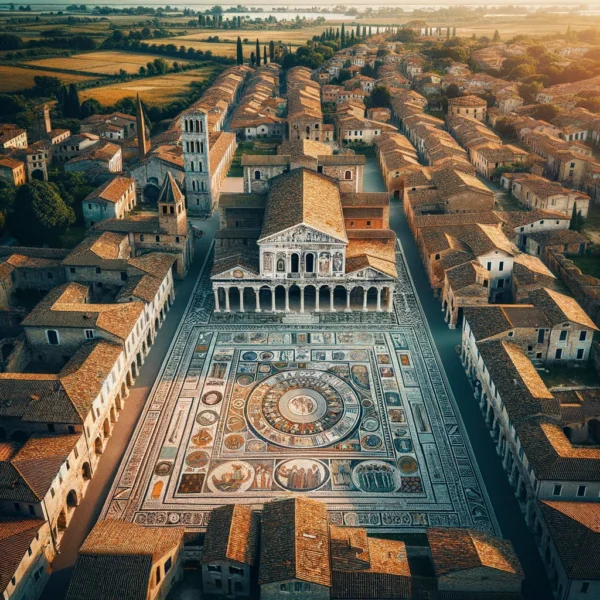
Wine Buying and Recommendations
For those looking to purchase, the region’s wines are accessible globally, but nothing beats buying directly from the source.
Vineyards often offer exclusive vintages or limited-edition bottles.
For a quintessential Friuli white, opt for a bottle of Friulano. If red is more to your liking, a Refosco will be a delightful addition to your collection.
Best Vintages in Friuli Venezia Giulia
When it comes to identifying the best vintages in Friuli Venezia Giulia, it’s important to recognize that the quality of a vintage can vary depending on the specific grape varieties and the microclimates within the region.
However, some years stand out for producing exceptionally high-quality wines across a range of varietals.
Here are some of the standout vintages:
2016: This year was remarkable for both white and red wines in Friuli Venezia Giulia.
The whites are particularly noted for their balance and aromatic complexity, while the reds are appreciated for their structure and aging potential.
2012: Known for its excellent conditions for white wine production, 2012 yielded wines with great aromatic intensity and a good balance of acidity.
2010: A vintage that stands out for its exceptional white wines, characterized by high acidity and strong mineral notes, making them particularly suitable for aging.
2006: This year provided favorable conditions for both reds and whites.
The red wines from this vintage are noted for their depth and complexity, while the whites are praised for their vibrancy and freshness.
2004: A vintage that was particularly good for red wines in the region, producing robust and structured wines with significant aging potential.
2001: Noted for producing excellent white wines with high acidity and complex flavors, ideal for those who prefer a more mature white wine.
It’s worth noting that wine vintages can be quite subjective and personal preferences play a significant role.
Additionally, the rapidly evolving nature of winemaking and climate patterns means that more recent vintages may also have outstanding years that have not yet been universally recognized or fully matured.
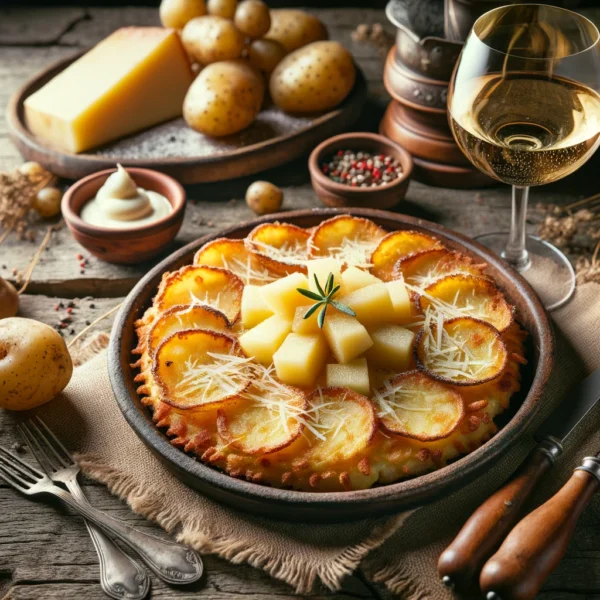
Cultural and Gastronomical Context
Friuli Venezia Giulia’s wines are intrinsically linked to its culture and cuisine.
Local dishes, often simple yet flavorful, are designed to complement the wines.
A glass of Friulano is typically paired with the region’s famous San Daniele ham, creating a harmony of flavors.
Friuli Venezia Giulia, with its rich culinary heritage, offers a plethora of special dishes that beautifully complement its diverse range of wines.
Here are some standout pairings:
Prosciutto di San Daniele with Friulano
This world-famous, sweet, and delicate ham pairs wonderfully with Friulano, a flagship white wine of the region.
The wine’s crispness and slight almond note complement the ham’s rich flavor.
Frico (Cheese and Potato Dish) with Ribolla Gialla
Frico, made with Montasio cheese and potatoes, is a comfort food staple in Friuli Venezia Giulia.
Pair it with Ribolla Gialla, a white wine with bright acidity and citrus notes, to cut through the richness of the dish.
Polenta e Osei (Polenta with Bird) with Refosco dal Peduncolo Rosso
This hearty dish of polenta and marinated bird meat pairs nicely with Refosco, a robust red wine.
The wine’s berry flavors and tannins balance the savory, rich flavors of the dish.
Brovada e Muset (Turnips and Sausage) with Schioppettino
Brovada, made from turnips fermented in grape pomace, served with muset, a spiced pork sausage, is a traditional dish.
A glass of Schioppettino, with its peppery and berry notes, complements the spiciness and tanginess of the dish.
Baccalà alla Triestina (Trieste-Style Salt Cod) with Malvasia Istriana
This creamy, rich salt cod dish is a treat when paired with Malvasia Istriana, a white wine with floral and peachy aromatics, which balances the dish’s richness.
Gubana (Nut and Dried Fruit Cake) with Picolit
For dessert, Gubana, a sweet, nut-filled cake, is perfect with Picolit, a sweet dessert wine.
The wine’s honeyed notes and the cake’s nutty flavors create a delightful harmony.
These pairings showcase the region’s ability to create a perfect marriage between its food and wine, each enhancing the other’s flavors and offering a true taste of Friuli Venezia Giulia’s culinary richness.
In conclusion, Friuli Venezia Giulia isn’t just a region; it’s a narrative of flavors, traditions, and innovations, all bottled up in each glass of wine it produces.
Whether you’re a casual drinker or a connoisseur, this region offers a journey through some of the most distinctive and delightful wines in the world.
Cheers to discovering the liquid treasures of Friuli Venezia Giulia!
FAQs:
Q1: What makes Friuli Venezia Giulia a unique wine region?
A1: Friuli Venezia Giulia’s uniqueness stems from its diverse terroir, blending alpine and Mediterranean climates, and a rich variety of soil types.
This region is renowned for its excellent white wines, made from both indigenous and international grape varieties, and its commitment to quality and innovation in winemaking.
Q2: Which are the most famous grape varieties in Friuli Venezia Giulia?
A2: The region is best known for its white grape varieties, such as Friulano, Ribolla Gialla, and Malvasia Istriana.
For reds, Refosco dal Peduncolo Rosso, Merlot, and Schioppettino are notable.
Q3: Can I visit vineyards in Friuli Venezia Giulia for wine tasting and tours?
A3: Absolutely! Friuli Venezia Giulia offers a range of wine tourism experiences, including vineyard tours, tastings, and educational sessions.
These activities provide an immersive experience into the region’s winemaking process and traditions.
Q4: Are there any specific wine designations in Friuli Venezia Giulia?
A4: Yes, the region has several wine designations, including DOC (Denominazione di Origine Controllata) and IGT (Indicazione Geografica Tipica).
These classifications guarantee the quality and geographical origin of the wines.
Q5: What food pairings work well with Friuli Venezia Giulia wines?
A5: The region’s crisp white wines, like Friulano, pair wonderfully with seafood and cured meats, such as the famous San Daniele ham.
The robust reds, like Refosco, complement red meats and hearty pasta dishes.
Q6: What is the best time of year to visit Friuli Venezia Giulia for wine enthusiasts?
A6: Late summer to early fall is ideal, especially during the grape harvest season.
Visitors can enjoy the vibrant atmosphere of the vineyards and possibly participate in the harvest.
Q7: Are Friuli Venezia Giulia wines available internationally?
A7: Yes, many wines from Friuli Venezia Giulia are exported and available in various countries.
However, visiting the region offers access to a wider variety, including limited editions and vineyard-exclusive bottles.
Q8: What is the impact of the region’s climate on its wines?
A8: The balanced maritime and continental climate contributes to slow grape ripening, resulting in wines that are both flavorful and have a refreshing acidity, a hallmark of the region’s wines.
Q9: Does Friuli Venezia Giulia produce organic or biodynamic wines?
A9: Yes, there’s a growing trend towards organic and biodynamic practices in the region, with many vineyards adopting sustainable methods to create environmentally friendly wines.
Q10: How does the soil composition affect the wines of Friuli Venezia Giulia?
A10: The varied soil types, from mineral-rich rocky soils in hilly areas to fertile plains, significantly influence the flavor profiles and characteristics of the wines, adding to their complexity and uniqueness.

Experience Wine Like Never Before with Coravin!
🍷 Introducing the Coravin Model Limited Edition Wine Preservation System in Steel Blue 🍷
🌟 Savor Every Drop: Why settle for just one bottle? With Coravin, enjoy any wine, any time, without ever pulling the cork. Your wine collection, unlocked with unparalleled freedom.
💎 Elegant Design, Superior Quality: Crafted in stunning Steel Blue and made with durable stainless steel, this isn’t just a wine tool; it’s a centerpiece that speaks to your sophisticated taste.
🚀 State-of-the-Art Technology: Featuring a Teflon coated wine needle, pour your wine smoothly and effortlessly, preserving every cork and every flavor.
🌬️ Ultimate Preservation: Each Coravin capsule uses ultra-pure argon gas to protect your wine from oxidation. Your last glass will be just as perfect as your first, even years later.
🎉 Perfect for Every Occasion: Whether you’re hosting a party or enjoying a quiet evening, Coravin ensures your favorite wine is always on the menu.
💡 Easy and Convenient: Celebrated for its ease of use and light weight, make every pour a joyous experience.
💸 A Wise Investment: Praised for its value for money, Coravin is not just a luxury; it’s an essential for every wine lover.
🌐 Ready for the World: Designed for US outlets but adaptable globally, your Coravin experience knows no bounds.
👉 Get Yours Today! Elevate your wine experience with Coravin. 🍇✨




